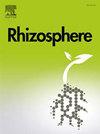Decline of beech trees in a Mediterranean forest is associated with high rhizosphere oomycete diversity
IF 3.4
3区 生物学
Q1 PLANT SCIENCES
引用次数: 0
Abstract
In the last decades, tree decline in European beech forests has been related to extreme climatic events and with the activity of parasitic oomycetes such as Phytophthora species. In Spain, little is known about the association of beech decline and soil oomycete composition. We hypothesized that the weakening of beech trees is associated with the activity and proliferation of parasitic oomycetes. We studied the rhizosphere oomycete community of large beech trees located in one of the southernmost beech forests in Europe. From soil samples collected in the rhizosphere, we used a metabarcoding approach to explore the oomycete community associated to asymptomatic and declining trees. We also studied fine root parameters in both groups of trees. A total of 99 oomycete amplicon sequence variants (ASVs) were detected. Higher diversity and richness of oomycetes were observed in declining than in asymptomatic trees. The oomycete composition also differed between the two groups of trees. Declining trees showed lower fine root biomass and root density than asymptomatic trees, and root density was negatively correlated with the abundance of Pythium ASV counts. The genus Phytophthora, associated with beech decline in central Europe, was underrepresented in the oomycete community. The results suggest that decline-associated processes in beech trees are related with fine root weakening and loss which probably facilitates the entrance and colonization of opportunistic oomycete microbes. Although members in the genus Pythium do not seem to be a primary factor on beech decline, they probably contribute to the chronic decline of Fagus sylvatica trees.
地中海森林中榉树的衰退与根瘤菌多样性有关
在过去几十年中,欧洲山毛榉林树木的衰退与极端气候事件和寄生卵菌(如噬菌体)的活动有关。在西班牙,人们对山毛榉衰退与土壤卵菌组成的关系知之甚少。我们假设,榉树的衰弱与寄生真菌的活动和繁殖有关。我们研究了位于欧洲最南端山毛榉林之一的大型山毛榉树根瘤菌群落。从根瘤菌圈采集的土壤样本中,我们使用代谢编码方法探索了与无症状树和衰退树相关的卵菌群落。我们还研究了这两类树木的细根参数。共检测到 99 个卵菌扩增子序列变体(ASV)。衰退树的卵菌纲多样性和丰富度均高于无症状树。两类树木的卵菌组成也有所不同。衰退树木的细根生物量和根密度低于无症状树木,根密度与 Pythium ASV 数量呈负相关。与欧洲中部山毛榉衰退有关的疫霉属在卵菌群落中的代表性不足。研究结果表明,榉树的衰退过程与细根的削弱和损失有关,这可能有利于机会性卵菌微生物的进入和定殖。虽然腐霉菌属成员似乎并不是导致榉树衰退的主要因素,但它们很可能对榉树的长期衰退起到了推波助澜的作用。
本文章由计算机程序翻译,如有差异,请以英文原文为准。
求助全文
约1分钟内获得全文
求助全文
来源期刊

Rhizosphere
Agricultural and Biological Sciences-Agronomy and Crop Science
CiteScore
5.70
自引率
8.10%
发文量
155
审稿时长
29 days
期刊介绍:
Rhizosphere aims to advance the frontier of our understanding of plant-soil interactions. Rhizosphere is a multidisciplinary journal that publishes research on the interactions between plant roots, soil organisms, nutrients, and water. Except carbon fixation by photosynthesis, plants obtain all other elements primarily from soil through roots.
We are beginning to understand how communications at the rhizosphere, with soil organisms and other plant species, affect root exudates and nutrient uptake. This rapidly evolving subject utilizes molecular biology and genomic tools, food web or community structure manipulations, high performance liquid chromatography, isotopic analysis, diverse spectroscopic analytics, tomography and other microscopy, complex statistical and modeling tools.
 求助内容:
求助内容: 应助结果提醒方式:
应助结果提醒方式:


